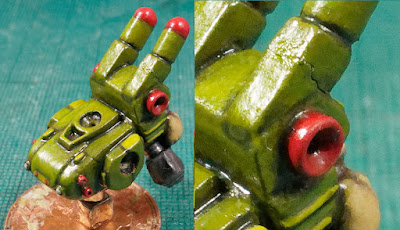Here's the second post describing what makes this game different from all the other wargames out there. The near future setting of Big Little Wars is one where technology is unevenly distributed. A reflection of the current situation here on Earth, projected onto the future.
The Gate Walker stories are set in a universe where alien civilizations millions of years ahead of us exist.
In some sense, the setting hearkens back to the warfare between mismatched forces of the colonial period. Except now, the boot is now on the other foot.
The game's rules must allow battles between asymmetrical forces.
This is opposite to what most conventional science fiction wargames try to do. The biggest franchises rules are for competitions between two player. Battles between nominally equally balanced armies, facing each other to see who wins.
Instead, Big Little Wars aims to provide rules to make playing unbalanced battles fun.
The emphasis being on the need to play to a force's strengths to achieve the scenario goal. Games where it is possible for both players to win or lose. The outcome of games creating stories for the reasons the battles were fought.
I stole this idea from role-playing games.
So, one step to achieving this is to focus on command and control. I originally intended to label these as different tech levels.
However, feedback suggests this name conveys engineering and weapons, which it sort of does. And, that's not the whole story of how technological sophistication is a force multiplier. Rather, my thoughts are that technology improves the ability to command and thereby control a force.
So, the four different levels are based on the ability to integrate technology to leverage command and control of a force.
• Command Level 1: Early to mid 20th Century (approximately circa 1920 to 1980).
• Command Level 2: Late 20th to early/mid 21st Century (approximately1980 to 2040).
• Command Level 3: Late 21st Century (starting circa 2040 to 2100).
• Command Level 4: Advanced alien technologies (specific to the alien force).
Let me expand that snapshot and my assumptions
Command Level 1
My assumption is that this is the natural outcome of industrialized warfare (sorry, I'm working from a data-set of one, so assumptions have to be made).
We see this transition from traditional first-generation warfare, maneuver of line and column, change when faced with machine guns and indirect fire. This led to what is called, second-generation war of fire and maneuver.
Command Level 2
This covers the developments that come from improved technology and training.
The transition from forces maneuvering to face each other, to wars of outmaneuvering the enemy, so called third-generational warfare.
Command Level 3
I've taken the liberty of disconnecting this assumption from the military theory of generational warfare.
This is the idea of a connected battlefield; warfare as an internet of things. Whether this will realistically be the case is another matter, but the war in Ukraine gives us a glimpse of war where a drone can be sent to deliver a package to an enemy soldier that will ruin his day.
Command Level 4
Is a catchall term for what comes next. A civilization where technology, psychology, and society have advanced so far that it's like looking into a singularity, where all within is hidden.
Or, if you prefer,:
“Any sufficiently advanced technology is indistinguishable from magic.”
In Big Little Wars, command level four will be reserved for aliens, or for settings that fall outside of the Gate Walker universe.
So, while I may not be planning on writing any scenario books involving giant super robots, or Kaiju that doesn't mean the the rules can't be used in such settings.
They're just not settings I'm expending my time on.







